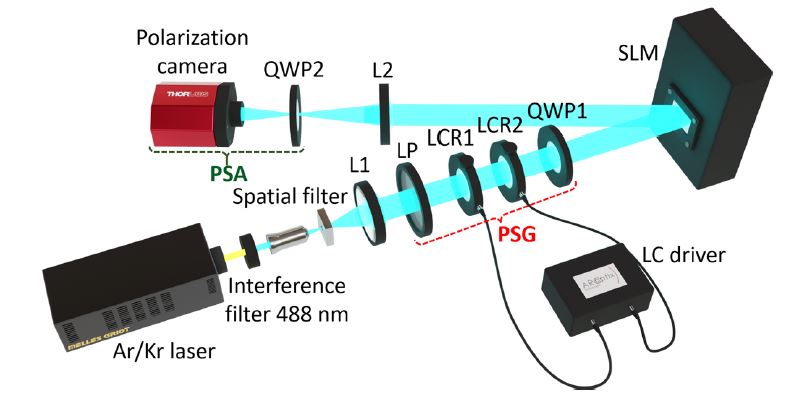 In our recent paper in Scientific Reports entitled Customized depolarization spatial patterns with dynamic retardance functions we demonstrate a proof-of-concept of a dynamical time-dependent pixelated retarder used to emulate a controlled spatially variant depolarizing sample.
In our recent paper in Scientific Reports entitled Customized depolarization spatial patterns with dynamic retardance functions we demonstrate a proof-of-concept of a dynamical time-dependent pixelated retarder used to emulate a controlled spatially variant depolarizing sample.
We apply an imaging Mueller polarimetric system based on a polarization camera to verify the effective depolarization effect, and the effective depolarizance results are fully described within a simple graphical approach and standard Mueller matrix decomposition methods. The technique is illustrated by means of three practical cases, including exotic structures as a spirally shaped depolarization pattern.
The work has been done in collaboration with our colleagues Angel Lizana and Juan Campos, from MIP Optilab Laboratory at the Department of Physics of Universitat Autònoma de Barcelona, in the frame of our common research project devoted to the development of advanced polarimetric systems.
This work is also part of the PhD Thesis of David Marco.
 A new paper is available at the journal Frontiers in Physics entitled Programmable supercontinuum laser spectrum generator based on a liquid-crystal on silicon spatial light modulator.
A new paper is available at the journal Frontiers in Physics entitled Programmable supercontinuum laser spectrum generator based on a liquid-crystal on silicon spatial light modulator.
In this work we present an optical system to spectrally filter a supercontinuum (SC) laser using liquid-crystal on silicon SLMs. The proposed optical system disperses the input laser and the spectrally separated components are projected onto the LCoS-SLM, where the state of polarization of each wavelength is separately modulated. Finally, recombining the modulated spectral components results in an output laser source where the spectrum can be controlled dynamically from a computer. The system incorporates two branches to independently control the visible (VIS) and the near infrared (NIR) spectral content, thus providing a SC laser source from 450 nm to 1600 nm with programmable spectrum.
We expect this new ability for controlling at will the wide spectra of the SC laser sources can be extremely useful for biological imaging applications.
This work was done with our former Master students Jordi Gomis and Pedro Martínez, and with Dr. Aarón Cofre after completing his PhD Thesis.
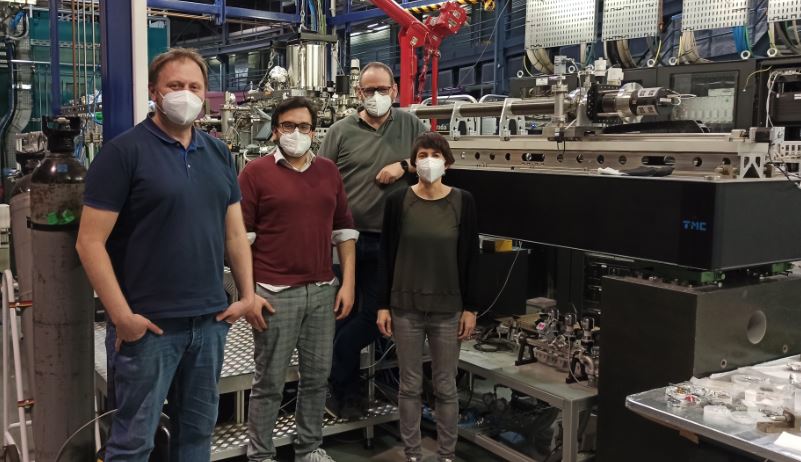 David Marco stayed for one month at ALBA synchrotron, where he collaborated in the implementation and calibration of a liquid-crystal on silicon spatial light modulator, to be used in a fluorescence microscope in one of the lines of ALBA.
David Marco stayed for one month at ALBA synchrotron, where he collaborated in the implementation and calibration of a liquid-crystal on silicon spatial light modulator, to be used in a fluorescence microscope in one of the lines of ALBA.
David has worked with experienced reserchers of ALBA, Eva Pereiro, Dominique Heinis and Josep Nicolás.
This stay was performed within the frame of our common national research project, coordinated by Prof. Juan Campos at Universitat Autònoma de Barcelona (UAB). This project involves the Optical Metrology & Image Processing Laboratory (MIP-OptiLab), the ALBA – Laboratory of Optics and TecnOPTO Laboratory.
This stay is also part of David’s training and research development within his PhD Thesis in the TECNIT PhD Program at UMH.
 A new paper is available at OSA Continuum entitled Encoding complex amplitude information onto phase-only diffractive optical elements using binary phase Nyquist gratings.
A new paper is available at OSA Continuum entitled Encoding complex amplitude information onto phase-only diffractive optical elements using binary phase Nyquist gratings.
In this new workwe reexamine a simple technique for encoding complex amplitude information onto a phase-only SLM. The approach uses a two-dimensional checkerboard binary phase diffraction grating where the diffraction efficiency is spatially varied.
We provide evidence of the usefulness of the technique but also about the limitations imposed by the current LCOS technology, which do not allow fully exploiting their high resolution, affected by the fringing effect.
The work has been done in collaboration with our coleagues at San Diego State University, Prof. Jeffrey A. Davis, Prof. Don M. Cottrell and Everett Wolfe.
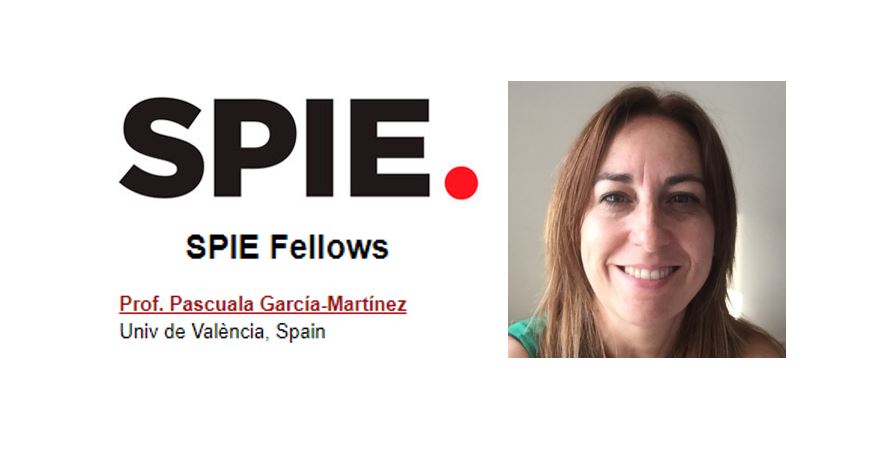 Prof. Pascuala García-Martínez has become a new 2021 SPIE Fellow member for her achievements in optical systems for image processing, diffractive optics and polarization, and for her activity on the promotion of women in science.
Prof. Pascuala García-Martínez has become a new 2021 SPIE Fellow member for her achievements in optical systems for image processing, diffractive optics and polarization, and for her activity on the promotion of women in science.
Access to her SPIE profile: Pascuala García-Martínez (spie.org)
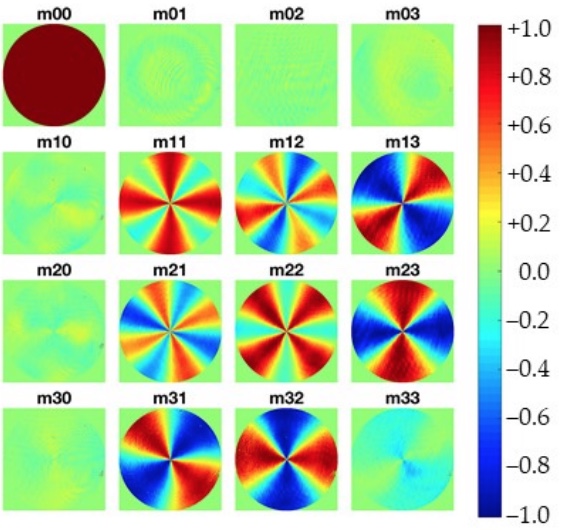
A new paper is available in the journal Crystals entitled Mueller matrix polarimetric imaging analysis of optical components for the generation of cylindrical vector beams, in a special issue of the journal devoted to Liquid Crystals Optical Devices.
In this work we perform a Mueller matrix imaging analysis of two commercial optical components usually employed to generate and manipulate vector beams—a radial polarizer and a liquid-crystal q-plate. These two elements generate vector beams by different polarization mechanisms—polarizance and retardance, respectively.
The quality of the vector beams relies on the quality of the device that generates them. For this purpose, we applied a customized imaging Mueller matrix polarimeter based on liquid-crystal retarders and a polarization camera. Experimental results were compared to the numerical simulations, considering the theoretical Mueller matrix.
This work was done in collaboration with our colleagues Angel Lizana and Juan Campos from the MIP-Optilab at Universitat Autònoma de Barcelona, in the frame of our coordinated national project.
viernes, 18 de diciembre de 2020
i.moreno
 Ignacio Moreno participated at SPIE Optics & Photonics conference – Digital Forum with two communications presented online. In the links below you can access the corresponding paper and presentation.
Ignacio Moreno participated at SPIE Optics & Photonics conference – Digital Forum with two communications presented online. In the links below you can access the corresponding paper and presentation.
I. Moreno, M. J. Yzuel, M. L. Calvo, “The International Day of Light in Spain – a three years perspective”, Proc. SPIE 11480, Optics Education and Outreach VI, 114800H (7 pp) (2020). LINK
I. Moreno, M. M. Sánchez-López P. García-Martínez, D. Marco, A. Vargas, G. López-Morales, J. C. Quiceno-Moreno, J. L. Martínez-Fuentes, “Efficient generation of vector beams”, invited talk, Proc. SPIE 11486, Laser Beam Shaping XX, 1148602 (9 pp) (2020). LINK
jueves, 3 de septiembre de 2020
i.moreno
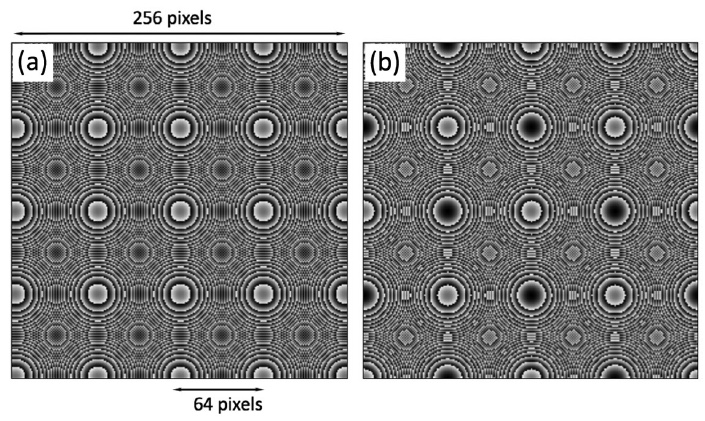 Our recent paper in the Journal of the Optical Society of America (JOSA A) is entitled In-phase sub-Nyquist lenslet arrays encoded onto spatial light modulators. Here we analyze diffractive lenses encoded onto SLMs when they surpass the Nyquist limit.
Our recent paper in the Journal of the Optical Society of America (JOSA A) is entitled In-phase sub-Nyquist lenslet arrays encoded onto spatial light modulators. Here we analyze diffractive lenses encoded onto SLMs when they surpass the Nyquist limit.
This limit happens when a focal length is encoded shorter than a given distance fixed by the spatial resolution of the the display. When this limit is surpassed, a two-dimensional array of lenslets is formed. We show that, for certain values of the focal length, the lenslets are all in perfect phase. We find other distances in between where the array � is composed of two sets of lenslets in phase opposition. Finally, we illustrate these phase distributions in the application to generate an array of vortex producing lenses.
This work has been done with our colleagues Prof. Don. M. Cottrell, Prof. Jeffrey A. Davis and Benjamin Gutierrez, from the Department of Physics at San Diego State University.
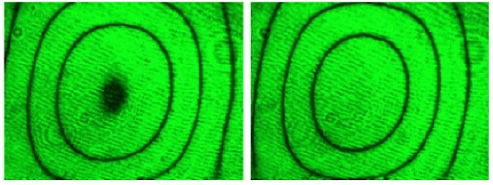 A new paper is available in Optics Letters entitled Measuring the spatial deformation of a liquid-crystal on silicon display with a self-interference effect.
A new paper is available in Optics Letters entitled Measuring the spatial deformation of a liquid-crystal on silicon display with a self-interference effect.
Here we present a simple technique to characterize the spatial non-uniformity of a LCOS-SLM, based on illuminating the display with a wavelength out of the operation range. In this situation there is a significant reflection at the output surface and a Gires–Tournois type interferometer is directly created, without any alignment requirement and insensitive to vibrations. The beam reflected at the output surface is the reference beam, while the beam reflected at the silicon backplane is modulated with the addressed gray level in order to quantitatively derive its deformation. We provide an experimental demonstration using a LCOS-SLM designed to operate in the near-infrared range but illuminated with visible light.
This work is part of the PhD Thesis of David Marco and has been done in collaboration with our colleague Prof. Asticio Vargas, from Universidad de La Frontera, Temuco, Chile.
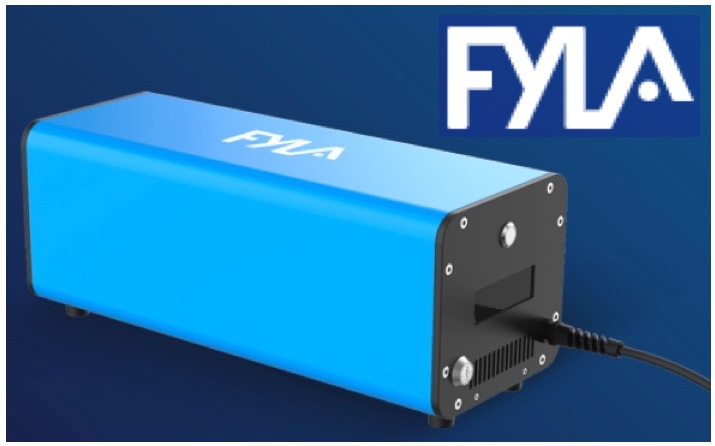 FYLA is a young Spanish laser company. At TecnOPTO we have two of their supercontinuum lasers.
FYLA is a young Spanish laser company. At TecnOPTO we have two of their supercontinuum lasers.
We use them in a variety of experiments that include the broadband characterization of optical retarders and iquid-crystal SLMs, and their use diffractive and optical information systems.
At the following link you can access the recent interview they made to Ignacio Moreno.
We thank Gaia Sardiello for her interview and collaboration.
 In our recent paper in Scientific Reports entitled Customized depolarization spatial patterns with dynamic retardance functions we demonstrate a proof-of-concept of a dynamical time-dependent pixelated retarder used to emulate a controlled spatially variant depolarizing sample.
In our recent paper in Scientific Reports entitled Customized depolarization spatial patterns with dynamic retardance functions we demonstrate a proof-of-concept of a dynamical time-dependent pixelated retarder used to emulate a controlled spatially variant depolarizing sample.







